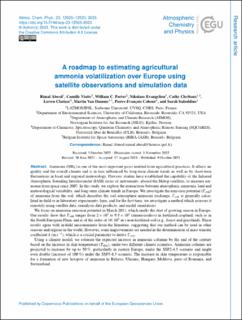| dc.description.abstract | Ammonia (NH3) is one of the most important gases emitted from agricultural practices. It affects air quality and the overall climate and is in turn influenced by long-term climate trends as well as by short-term fluctuations in local and regional meteorology. Previous studies have established the capability of the Infrared Atmospheric Sounding Interferometer (IASI) series of instruments, aboard the Metop satellites, to measure ammonia from space since 2007. In this study, we explore the interactions between atmospheric ammonia, land and meteorological variability, and long-term climate trends in Europe. We investigate the emission potential (Γsoil) of ammonia from the soil, which describes the soil–atmosphere ammonia exchange. Γsoil is generally calculated in-field or in laboratory experiments; here, and for the first time, we investigate a method which assesses it remotely using satellite data, reanalysis data products, and model simulations. We focus on ammonia emission potential in March 2011, which marks the start of growing season in Europe. Our results show that Γsoil ranges from 2 × 103 to 9.5 × 104 (dimensionless) in fertilized cropland, such as in the North European Plain, and is of the order of 10–102 in a non-fertilized soil (e.g., forest and grassland). These results agree with in-field measurements from the literature, suggesting that our method can be used in other seasons and regions in the world. However, some improvements are needed in the determination of mass transfer coefficient k (m s−1), which is a crucial parameter to derive Γsoil. Using a climate model, we estimate the expected increase in ammonia columns by the end of the century based on the increase in skin temperature (Tskin), under two different climate scenarios. Ammonia columns are projected to increase by up to 50 %, particularly in eastern Europe, under the SSP2-4.5 scenario and might even double (increase of 100 %) under the SSP5-8.5 scenario. The increase in skin temperature is responsible for a formation of new hotspots of ammonia in Belarus, Ukraine, Hungary, Moldova, parts of Romania, and Switzerland. | en_US |

